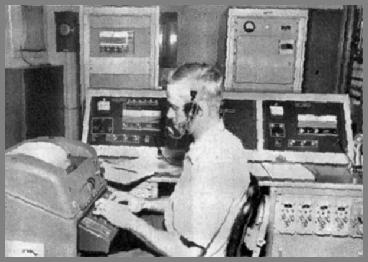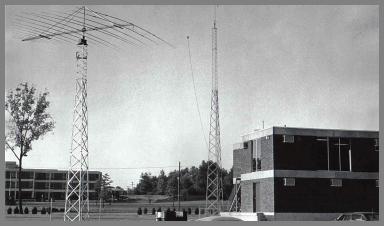
WFN - Louisville, KY
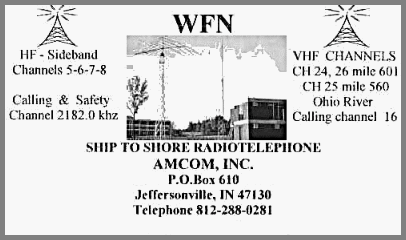
Here's
a
more elaborate WFN
Business Card
I remember hearing this Ship-to-Shore station as a teenager in 1950. It was AM at that time and the 6 MHz frequency came in loud and clear in northern Indiana. Though it was always called the Louisville station as it was first located there, for most of its life it was actually located across the river in Jeffersonville, IN.
Most of this material is courtesy of Paul Hise who held many electronics-related positions with WFN and American Commercial Barge Line (ACBL) and its parent company American Commercial Lines (ACL). When Paul retired in 1992 after 26 years of service he was Manager of Telecommunications for ACL.
The Early Years - Louisville and Jeffboat
The
1944 FCC Annual Report contains the following statement: "A new station
at Louisville, Ky., established for communication with ships on the
Mississippi River and connecting inland waters, began operation with
service tests in June, 1944." WFN was established
by Warner & Tamble of Memphis Tennessee, also owners of WJG in
Memphis. However, Jack Estes reports that, while there may
have been service tests in 1944, Warner & Tamble was very slow
to fully activate the station. It was 1950 when he installed
the original Western 24B equipment at WFN and put it on the air. The original
station was at the Port of Louisville Terminal in Louisville,
Kentucky. The Port of Louisville Terminal was located at the
foot of Preston Street at River Road, just west of the I65 Kennedy
Bridge - see map below. (Anyone
have a WFN QSL card?)
It is
believed that the station originally operated only on a 2 and a 4 mhz
frequency. (However, note
my 6 MHz comment above.) The first
operator was George Meyer (perhaps
assisted by his wife?).
He continued
to operate the station until the Inland River crew strike in
(1958?). This strike shutdown most of the ACBL
operation. When the strike ended in (1959?) the station was
re-activated in an electrical contractors building on Poplar
level Road in Louisville by operator Roy Harmon. Roy was a
former radio
operator for the Corp of Engineers and an exceptional
operator. He had a good radio voice, was able to work well
and decipher the conversation in the worst of conditions, and had a
good rapport with the captains and pilots.
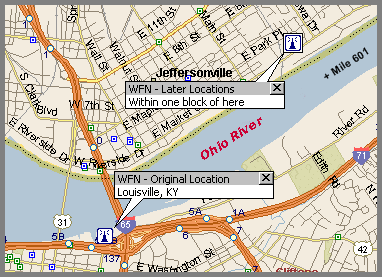 Early WFN Station Locations - The Poplar Level Road location is not shown on this map |
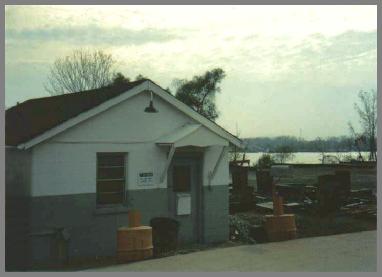 The Jeffboat WFN building taken years after the station had moved there - Paul Hise Photo |
|---|---|
In (1959?) or (1960?) the station was moved from the Poplar Level Road location to the Jeffboat shipyard in Jeffersonville, IN. At this time the ACBL offices were also at the shipyard. Warner & Tambel had the small concrete block building shown above constructed at the east end of the shipyard. Two 60 foot towers were erected on the river side of the building. Two multi-band off-center-fed wire antennas were installed between the towers and building. One antenna was a inverted V. At this time the communications media was Medium and High frequency using amplitude modulation (AM) in the two to eight megahertz band, The equipment was update to include a refurbished World War II Western Electric 250 watt 4 to 12 MHz transmitter and a RCA 8050 transceiver which was utilized as a guard for the 2182 and 2782 KHz frequencies as well as backup for the 4 and 6 MHz frequencies. In addition, several RCA 8050 transceivers were purchased and the receivers removed and utilized to provide monitoring of all available frequencies. This combination was controlled by a home brew multiple toggle switch remote console setting on a used U.S. Navy grey metal desk. A large back-lighted Raytheon advertisement clock provided the time. An eighteen inch window fan in the front window air-conditioned the building.
Paul started work at WFN on a part time basis from April to August of 1962. At that time the normal work hours were 6 to 6 Monday through Saturday and 6 to 1 on Sunday. Mr. Harmon had worked this schedule consistently over the years except for a few days off when WJG would operate the schedule from Memphis. In November of 1965 Paul, who was then working for the Indiana State Police, was offered a full-time operator position with ACBL by Captain Jack Wofford, ACBL Vice President of Operations. Roy Harmon had taken another job, and an operator was needed for WFN. Since Warner and Tamble then owned the station, Captain Wofford indicated that ACBL intended to purchase the the station from them if Paul would take the job. Wofford also indicated that ACBL was in the process of expanding its fleet and operation, and the advancement prospects within the company were good. Paul accepted the offer and began working on January 1, 1966.
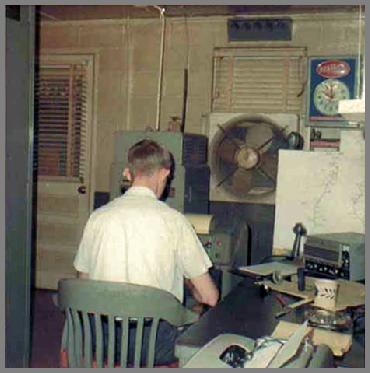 Paul Hise in the WFN Jeffboat Operating Room |
 Both Photos by Paul Hise - 1966 |
|---|---|
WFN operated under Amcom, Inc. a wholly owned subsidiary of American Commercial Barge Lines. As a Marine Public Coast Radio Station WFN was required to connect any telephone in the United States with any boat equipped to communicate with the station; but, in practice, it primarily served ACBL/ACL boats. Four schedules were called each day between 6 AM and 6 PM Monday through Saturday and 6 AM to 1 PM on Sunday. These schedules were for twenty to thirty boats, STEPHEN F. AUSTIN, LASALLE, RAYMOND E. SALVATI, PHILIP SPORN, SPENCER, PAT CALHOUN, JR., GIBRALTER I and TRADEWINDS to name a few. Boat orders were sent to the Station by landline teletype between schedules. During schedule time the teletype was used to record the boat traffic on line to the ACBL office. A paper teletype tape was cut for retransmission to provide multiple schedule copies for distribution to office personnel. The time between schedules was utilized to receive boat grocery orders to be forwarded to a boat store, to complete ship to shore radio/telephone calls, maintain the equipment at the station and at times to provide electronic maintenance to boats in for repairs at the shipyard.
1965 to 1976 - SSB, New Location and Station Upgrades
VHF-FM service at Jeffersonville (OHR mile 601) was established in 1965 utilizing Calling Channel 16 and Channel 26. In 1969 Channel 24 was added at Jeffersonville and an additional remotely-controlled VHF station on channel 25 with a separate channel 16 calling channel was activated at Madison Indiana (OHR mile 560). Later, after the 1973 tornadoes, this station was moved across the river to Milton Kentucky, still at mile 560.
In early 1967 experiments with high frequency sideband radio were undertaken, and plans were developed to relocate the station to a new building and facilities. Operations began in the new facility at 1700 East Market Street in December 1967 - Press Release. This new WFN building was constructed to be waterproof and operational during floods. The upper floor was about 1 foot above the 1937 flood level. All electric, telephone and antenna feeds were waterproof. A new 1000 watt Single Sideband Transmitter, state of the art receivers, VHF-FM transceivers and a custom designed control console were the heart of the operation. Antennas on the 12 acre site included a new half-wave dipole antenna for each frequency band and seven towers from 60 to 90 feet tall.
By 1967 the number of schedules called each day had increased to 5 as shown on this Position Schedule Sheet. Both companies shown on this sheet were ACL subsidiaries. By 1982 this was up to 6 schedules per day. The station went to a 24 hour schedule in 1968, first just the VHF-FM and then in 1969 with HF. Station managers in this time period were Roy Harmon from August 1969 to March 1973 and Robert Grau from July 1973 to September 1974. Here, couresy of Jeff Yates, is a 1968 WFN QSL card .
In August of 1969 Paul was offered, and accepted, the job of Marine Electronic Technician by Captain Jack Bullard, ACBL Marine Superintendent. Bobby Gloyd who had held this job since 1965 had accepted another position. Paul also continued to supervise WFN’s overall operation with Roy Harmon, who had returned as an operator at WFN, managing the day to day operation of the station.
In 1974 a 1600 sq. ft. two-story addition was added to the WFN building. The top floor was to accommodate the expansion of WFN's operating positions to 3 positions. The lower floor was the new electronic repair facility. This addition compromised the flood-proofing to some extent as an emergency generator on the back platform was 7 feet below the 1937 crest. However, the original feeds remained waterproof to the upper floor.
During 1973-4 when Robert Grau was the Station manager WFN conducted tests of Radio Teletype as a means of communicating with the towboats. Here is the report to the FCC on those tests.
1976 - The Elizabeth, IN Site
Unfortunately, soon after the building expansion was completed the electric utility company upgraded its primary feed line along Market Street to 167000 Volts. This new line produced considerable low frequency RFI marginalizing WFN’s reception on most frequencies. This interference required the relocation of WFN’s main transmitters, receivers and antennas. The construction of a new remotely-controlled station on a 60 acre site 15 air miles west and north of the Ohio River near Elizabeth Indiana off SR11 was undertaken.
At the Elizabeth site a 20 x 30 foot steel insulated building was constructed, and new CIA transmitters and receivers were installed feeding two directional TCI wire log periodic antennas. The smallest, a bi-directional oriented within 5 degrees of east and west to provide coverage for the Ohio, Upper Mississippi and Illinois Waterway, was installed on a 132 foot guyed tower. The other TCI wire log-periodic, covering from the station south to Mobile, AL and west to Brownsville TX, was constructed over a 225 foot guyed tower and with the adjacent catenaries took up nearing five acres. In addition a Hy-Gain 6 to 30 MHz. log periodic was installed on the 150 foot microwave tower and positioned to provide additional coverage to the Upper Mississippi and Missouri Rivers. Here's an image of a 1977 Towboat Tribune article with some pictures. This remote site was operated and controlled via a 2 GHz. Farinon microwave system from the ACBL building at 1701 E. Market St. Backup generators were installed to allow continuous operation. This remote site became operational in the fall of 1976, Perhaps all WFN operations at the 1700 E. Market St. building were terminated at this time?
The Later Years - SSB and Beyond
During the period from 1968 to 1976 Sideband and VHF-FM transceiver installations were completed on all ACBL boats. A new towboat construction program was initiated using the newest electronic and navigation equipment. The first duplex analog data communications were conducted between WFN and the M/V BILL ELMER on the Mississippi River utilizing frequencies in the 6Mhz band. In 1980 the developmental data radio system was completed and the first digital data communications were transmitted between the station and the M/V SONNY IVEY utilizing VHF frequencies. Here's an image of a 1980 article with more detail on this.
WFN station managers during this time period were: Harold Mauck from 1975 to 1980 and Lemuel Greer from 1980 until his retirement in 1988. Here are images of a three page article from early 1982 that give more detail on the station's operation and personnel at that time: Page 1 Page 2 Page 3
Early in 1987 the WFN operating consoles were redesigned and the WFN operating positions were moved to 453 E. Park Place just north of the ACL building. The new consoles used telephone switching technology to operate the station and provide enhanced ship to shore telephone calls.
It would be nice if more were known about the winding down of WFN. When did WFN cease operation on HF, and decommission the Park Place operating consoles and Elizabeth site?
ACL assumed control of WATERCOM in 1982, and its 216-220 MHz FM Waterway Communications Systems AMTS began operation in 1985 on the Ohio River with full public operation commencing in 1986. Wish I knew more about WATERCOM - similar to the information on the WMI-VHF page.

